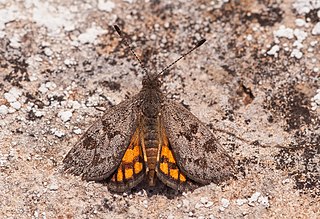| Synemon | |
|---|---|
 | |
| Synemon discalis | |
| Scientific classification | |
| Domain: | Eukaryota |
| Kingdom: | Animalia |
| Phylum: | Arthropoda |
| Class: | Insecta |
| Order: | Lepidoptera |
| Family: | Castniidae |
| Subfamily: | Castniinae |
| Tribe: | Synemonini |
| Genus: | Synemon Doubleday, 1846 |
| Species | |
See text | |
Synemon (commonly known as the Sun-moths) is a genus of moths within the family Castniidae. It was described by Edward Doubleday in 1846. [1] The genus contains 24 described and 20 undescribed species. [2] These species are found across mainland Australia and on Kangaroo Island, with the highest diversity in Western Australia. [2] Synemon species can be found in a range of habitats, including woodlands, heathlands and native perennial grasslands. [2] The adults fly during the daytime in warm to hot weather. [2] They have clubbed antennae, and are often mistaken for butterflies. [3]
Sun-moths typically have dull coloured forewings which, at rest, conceal their brightly coloured hindwings. [2] The hindwings can be used to startle potential predators. [3] All known larvae of sun-moths feed on monocotyledonous plants, such as Rytidosperma , Gahnia , Lepidosperma and Lomandra. [3] Since European settlement, many species have suffered drastic reductions in their distributions due to habitat loss from agriculture and other threats. [2] Some are listed as threatened, including Synemon plana, which is listed as critically endangered under the Australian Government Environment Protection and Biodiversity Conservation Act 1999 . [4]







